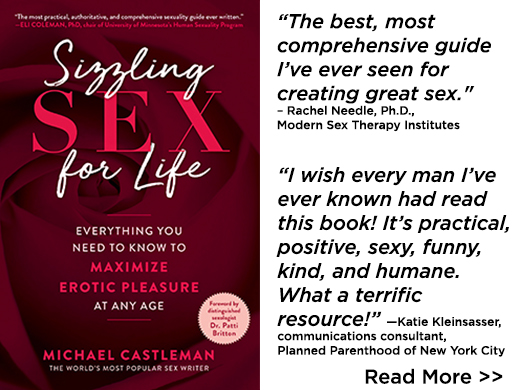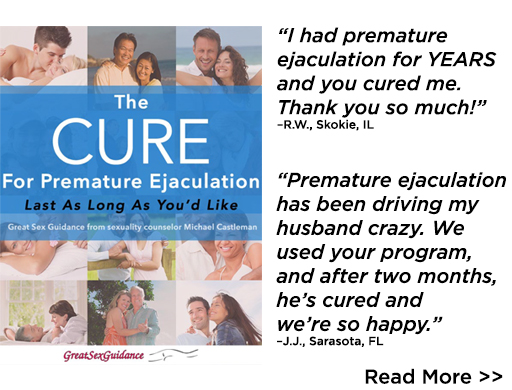
Read Part 1 here and Part 2 here.
In alleged “sex addiction,” the real issues are usually guilt and shame about being sexual.
Sex comes in three varieties: procreative, relationship-affirming, and recreational. Humans have always indulged in all three. But from Biblical times through the 18th century, the only God-fearing justification was procreation. This made some sense in an agrarian economy where more children meant more hands to work the fields.
The Industrial Revolution changed that. Urbanized factory work led to smaller families, and religious thinking changed. God’s favorite reason for sex remained procreation, but as farming yielded to wage labor, theologians decided the Almighty also approved of sex to affirm relationships.
Meanwhile, Western culture has always included an undercurrent of recreational nookie: mistresses, sex work, and other types of non-monogamy.
Over the past 70 years, researchers have confirmed the tremendous diversity of sexuality, shattering all illusions that Americans get down only for God’s two approved reasons. The large majority of Americans have enjoyed some forms of recreational sex, and many routinely play that way.
Recreational Sex May Cause Anxiety, Guilt, and Shame
Recreational sex is everywhere. Where would literature, movies, and TV be without it? But religious conservatives call it sin, while cultural conservatives brand it “sex addiction.”
Many people raised in socially conservative households feel distress about recreational whoopee, particularly solo sex, especially self-sexing to porn. When some women discover that their men stroke to porn, they flip. You’re a sex addict! For men who feel conflicted about sex, to begin with, this accusation reinforces a lifetime of sexual confusion, guilt, and shame.
Why do people decide they’re “sex addicts?” The one consistent predictor is deeply religious upbringing:
- Croatian researchers surveyed 1,998 men. Among the most sexually active, most felt fine about their frequency, while some reported distress. The latter were usually deeply religious and raised to consider recreational sex immoral.
- University of Oklahoma investigators asked 771 men and 904 women what they thought of porn. Those who condemned it tended to identify as fundamentalist, and reported the greatest guilt and shame about viewing.
- Case Western Reserve scientists asked 2,232 adults if they felt addicted to Internet porn. Some replied “yes,” others “no.” The only difference between the two groups—identification with religions that condemn masturbation and porn.
Sex addiction is rarely about “excessive” or “disordered” sex. It’s almost always about the confusion, guilt, and shame some people feel about being sexual—especially self-sexing while viewing porn.
How Prevalent Is “Out-of-Control” Sex?
For all the discussion of “sex addiction,” it’s remarkable how little research has explored its general prevalence. The best analysis is a New Zealand study of 940 adults. Thirteen percent of the men and 7 percent of the women said that sometime during the previous year, they’d felt sexually out of control.
But feelings are not actions. Feelings often manifest as erotic fantasies, which are totally normal and healthy. Wild, weird erotic feelings may be disconcerting, but they cause no harm and are not a social problem.
The real issue is sexual actions. Fewer than 1 percent said their sexual activities had ever interfered with their lives—0.8 percent of the men, and 0.6 percent of the women, seven people per 1,000.
Actually, these figures are over-estimates. Many who reported “out-of-control” sex cited gay/lesbian encounters. But same-sex lovemaking is not out of control. It’s normal and fine.
Many of the men in the New Zealand survey called any paid sex “out of control.” Whatever you think of prostitution, an estimated 15 to 20 percent of American men have paid for sex. Some of this may signal compulsivity, but for many men, visits to sex workers reconcile big libidos with chronic marital desire differences. One Portland, Oregon, sex worker surveyed her customers, asking why they visited her. Among her married clients, the number one reason was “to save my marriage.” One may disapprove of patronizing sex workers, but paying for sex is not necessarily out of control. It may be a reasonably rational solution to chronic marital desire differences.
Many of the women said they’d acted out of control because they’d had multiple partners. Society often calls such women “sluts,” leading some to feel that something is wrong with them. But the one study of highly sexual women shows them solidly in control of themselves. Compared with other women, they just enjoy sex more.
So chances are that fewer than 7 people per 1,000 have actually acted sexually out of control, way fewer than the sex-addiction industry claims.
Worried You Might Have a Sex/Porn Problem?
Let’s say that 5 people per thousand (0.5 percent) have sex that actually harms them and/or others. That’s a tiny percentage of the population, but in a nation of 250 million people over age fourteen, it’s 1.5 million people. If you fear you’re among them:
Step 1. Why do you think you’re out of control?
- Thoughts? If your thoughts are the issue, you’re normal. Everyone has erotic thoughts. Many have them several times a day. And many have erotic fantasies they find disturbing. But we’re not responsible for our thoughts, only our actions. Don’t stress about your fantasies.
- Actions? Many call themselves “sex addicts” for sex that’s not heterosexual and monogamous. But same-sex relationships are normal. So is consensual non-monogamy—more below.
- Upbringing? Did your parents or church harangue you that masturbation and recreational sex are evil? Believe what you want, but more than 70 years of research show that self-sexing is normal and healthy, even when people stroke frequently. In addition, most Americans have engaged in recreational sex—and usually, feel fine about it.
- Who? Who says your sexual activities are problematic? You? Or your partner? If it’s you, here’s the test. Do your sexual actions significantly interfere with your daily responsibilities to school, work, family, and friends? If so, proceed to Steps 3 and 4.
If it’s your partner, ask why he or she—probably she—thinks so. Your partner may be mistaken:
- Some women believe that only reprehensible men watch porn. Actually, virtually all men do.
- Some women believe that porn is violent and promotes sexual assault. In fact, porn is less violent than standard television fare video games and does not contribute to rape. Worldwide, as porn has become more easily available, rates of sexual assault, including child sex abuse, have decreased.
- Some women believe that porn corrupts adolescents. However, since the arrival of Internet porn, young people have become more sexually responsible—more likely than ever postpone first intercourse until after high school graduation, and then to practice safe sex.
- Some women believe that women who work in porn have been trafficked and live as virtual sex slaves. Actually, the women in porn are very similar to other women. They just enjoy sex more.
Some women don’t object to porn, per se, but feel threatened by men’s stroking to it. Sorry, ladies, marriage licenses don’t grant you the right to prohibit a partner’s self-sexing any more than they give your man the right to keep you from talking with your friends.
There is, however, one legitimate objection to porn—men habitually stroking to it while refusing to make love with their partners (below).
Step 2. If you’re concerned about your actions, which one(s)? Why?
Among women, the leading reason for self-diagnosis of “sex addiction” is multiple partners. Supposedly, “good girls” have just one.
But the leading erotic fantasy involves doing it with someone other than your main partner. Don’t berate yourself for your daydreams. In fantasy, everything is permitted and nothing is wrong.
What about real live sex with many lovers? There’s nothing necessarily “disordered” about this. Throughout history, many normal, mentally healthy women have participated in unconventional couplings. Today, around 5 percent of American women enjoy threesomes, swapping, and swinging. That’s who they are. Unless non-monogamy significantly interferes with life responsibilities, it’s not problematic, not an “addiction.”
Among men, the top concern is masturbation to porn. However, on closer examination, the problem is rarely stroking to porn, per se, but the guilt and shame men feel about yanking.
Step 3. If you still think your actions are out of control, treat the situation as a habit you’d like to change.
- If at first… Many people try to lose weight or stop watching porn—and fail. They may conclude, “This habit is stronger than I am. I must be an addict.” Actually, you have a habit you’d like to change. This is a learning process. You may need several tries to figure out what works for you. Keep trying. Eventually, you’re likely to succeed
- Itemize your triggers. Triggers are the moments you feel a strong pull toward your habit. Frequently, triggers include boredom, stress, loneliness, or the end of the workday (Traffic to PornHub, the world’s largest porn site, spikes from 5-6 p.m.). Once you identify your triggers, work around them.
- Ten minutes. Next time you feel triggered, instead of slipping into your habit, for just 10 minutes, do something else—anything. Ten minutes isn’t long. Even those in the grip of tenacious habits like smoking can usually do something else for 10 minutes. Take a walk. Run an errand. Make a cup of tea. Meditate. Call a friend—anything that postpones indulging.
- Another ten? Okay, you went 10 minutes. See? Your habit doesn’t totally control you. You’ve exerted some control over it. Congratulations. You’re on your way to overcoming it. After 10 minutes, decide if you can postpone your habit another 10 minutes. If not, don’t berate yourself. Habits often change slowly. Over time, extend one 10-minute avoidance period to several. You don’t have to stop watching porn entirely. Just confine it in a smaller corner of your life.
- Which substitute works best? Experiment to identify the activities that best allow you to postpone your habit. Embrace them whenever you feel triggered.
- Relapses? Some people quit smoking or drinking or porn cold turkey, but most can’t. If you fall off the wagon, pick yourself up, analyze why you couldn’t resist your trigger, and reset with another 10 minutes of avoidance.
Step 4. Still need help? Consult a mental health professional who uses cognitive behavioral therapy (CBT) or its offshoot, acceptance, and commitment therapy (ACT).
Fear of being out of control causes anxiety and efforts to find soothing relief. When masturbation to porn causes anxiety, some men self-soothe with more masturbation to more porn. This creates vicious cycle: stroking, anxiety, more stroking, greater anxiety, and on and on.
“Cognitive” means thinking. CBT/ACT are simple yet powerful approaches to loosening the grip of anxiety-producing stressors by changing how we think about them. Mistaken thoughts can cause great distress. CBT/ACT corrects false beliefs. As a result, those in distress calm down, and are often able to break their vicious cycles.
One common thought error is “catastrophizing,” making a big deal out of minor annoyances. You miss a flight. Catastrophizers might think, My life is ruined. Now missing a flight can be a hassle, but there are other flights, and if you have to rearrange your schedule, you can. CBT/ACT therapists help people recognize catastrophizing and correct flawed thinking, which reduces anxiety and acting out.
Sexual catastrophizing includes:
- Sexual thoughts and fantasies are wrong, harmful, sinful.
- Only bad people masturbate.
- Porn is evil.
CBT/ACT therapists de-catastrophize those ideas:
- There’s nothing wrong with sexual thoughts and fantasies. Everyone has them. They’re perfectly normal and a key element of great sex.
- Almost everyone masturbates, particularly men who feel stressed. Unless it interferes with life responsibilities or partner lovemaking, there’s nothing wrong with it, no matter how frequent.
- Porn is not evil. It’s a cartoon version of men’s fantasies of effortless sexual abundance. Virtually every Internet-connected man on Earth has seen porn, many frequently, some daily.
Several studies show that CBT/ACT works well for those who believe their sexuality is out of control:
- Swedish scientists used CBT to treat ten men for severe anxiety caused by their porn consumption. After seven sessions (seventeen hours total), their distress and porn viewing declined significantly and remained low six months later.
- A Harvard researcher studied twenty-eight adult men in distress because of pornography. Some were placed on a wait list. The rest received twelve sessions of ACT. The wait-list group showed scant change in porn viewing, but the ACT group reported significant reductions that remained the case three months later.
- Creighton University investigators took thirty-eight men convinced they were porn addicts to a rustic retreat center for eight-days. They spent thirty-two hours in mindfulness meditation instruction and CBT. Their sexual anxiety and porn viewing decreased significantly.
Find a CBT therapist near you visit the National Association of Cognitive-Behavioral Therapists (nacbt.org). To find an ACT professional, visit https://www.psychologytoday.com/us/therapists/acceptance-and-commitment-therapy-act.
Or consult a sex therapist credentialed by the American Association of Sex Educators, Counselors, and Therapists (AASECT). Many offer CBT/ACT. Their training incorporates current sex research, so they have the knowledge to correct mistaken sexual beliefs. They appreciate the great diversity of normal, healthy sexuality. They do not condemn masturbation. They understand that while sex may cause problems, for the vast majority of people, lovemaking—solo or partnered however frequent—usually brings pleasure, not addiction. To find an AASECT-certified sex therapist near you, visit aasect.org.
If You’d Rather Stroke to Porn Than Make Love with Your Partner
Solo sex while watching porn is usually fine, as long as it doesn’t interfere with the rest of your life—including sex with your honey. In sexual relationships, couples have a responsibility to make love at a frequency both can live with.
Here’s what sex therapists recommend: Schedule your partner sex in advance and stroke at other times. Independent of porn, in long-term relationships, desire differences are virtually inevitable. Scheduling sex is the best way around them. When porn is an issue, scheduling becomes even more crucial. With scheduled sex, women can feel reassured that their men still desire them and make time to make love with them. Meanwhile, men can play solo at times that don’t interfere with scheduled partner sex.
Some older men find that it’s easier to become aroused and raise erections stroking to porn than in partner lovemaking. You CAN become aroused with your lover. Just breathe deeply, engaging in lots of kissing, cuddling, and mutual whole-body massage. And if you don’t get hard enough for intercourse, you can still enjoy satisfying, orgasmic “outercourse:” hand jobs, oral sex, and if you feel so inclined, perhaps a bit of kink.
A very small proportion of the population exhibits truly out-of-control sexuality. For them, habit-change and sex therapy usually resolve the problem. Unfortunately, the sex-addiction industry has vastly over-stated extent of out-of-control sexuality, and their treatment approaches rarely focus on the guilt and shame at the heart of most “sex addiction.” That’s why most mental health professionals reject “sex addiction” as large fiction.
———-
Part 1 of this series explores whether habits like frequent porn watching constitute actual “addictions.” Part 2 explores the harm supposedly inflicted by “sex addiction.”
More great, useful sex information from Michael Castleman, the world’s most popular sexuality writer.
The Cure for Premature Ejaculation
References:
The real culprits in “sex addiction:” sexual guilt and shame
Gilliland, R. et al. “The Roles of Guilt and Shame I Hypersexual Behavior,” Sexual Addiction and Compulsivity (2011) 18:12.
Grubbs, J.B. et al. “Internet Pornography Use, Perceived Addiction, and Religious/Spiritual Struggles,” Archives of Sexual Behavior (2017) 46:1733
Perry, S.L. and K.J. Snawder. “Pornography, Religion, and Parent-Child Relationship Quality,” Archives of Sexual Behavior (2017) 46:1747.
Stulhofer, A. et al. “Is High Sexual Desire A Facet of Male Hypersexuality? Results from an Online Study,” Journal of Sex and Marital Therapy (2016) 42:665.
The prevalence of “out of control” sexual behavior
Skegg, K. et al. “Perceived ‘Out of Control’ Sexual Behavior in a Cohort of Young Adults from the Dunedin Multidisciplinary Health and Development Study,” Archives of Sexual Behavior (2010) 39:968.
Highly sexual women
Blumberg, E. “The Lives and Voices of Highly Sexual Women,” Journal of Sex Research (2003) 40:146.
Studies showing more porn, less rape
Condron, M.K. and D.E. Nutter. “A Preliminary Examination of the Pornography Experience of Sex Offenders, Parphiliacs, Sexual Dysfunction Patients, and Controls Based on Meese Commission Recommendations,” Journal of Sex and Marital Therapy (1988) 14:285.
Cook, R.F. et al. “Pornography and the Sex Offender: Patterns of Previous Exposure and Arousal Effects of Pornographic Stimuli,” Journal of Applied Psychology (1971) 55:503.
Fisher, W.A. et al. “Pornography, Sex Crime, and Paraphilia,” Current Psychiatry Reports (2013) 15:362.
Fukui, A. and B. Westmore. “To See Or Not To See: The Debate Over Pornography and Its Relationship to Sexual Aggression,” Australia and New Zealand Journal of Psychiatry (1994) 28:600.
Goldstein, M. et al. “Experience with Pornography: Rapists, Pedophiles, Homosexuals, Transsexuals, and Controls,” Archives of Sexual Behavior (1997) 1:1.
Gwee, K.P. et al. “The Sexual Profile of Rapists in Singapore,” Medicine, Science and the Law (2002) 42:51.
Kohut, T. et al. “Is Pornography Really About ‘Making Hate to Women?’ Pornography Users Hold More Gender-Egalitarian Attitudes Than Nonusers in a Representative American Sample,” Journal of Sex Research (2016) 53:1.
Langevin, R. et al. “Pornography and Sexual Offences,” Annals of Sex Research (1988) 1:335.
Nutter, D.E. and M.E. Kearns. “Patterns of Exposure to Sexually Explicit Material Among Sex Offenders, Child Molesters, and Controls,” Journal of Sex and Marital Therapy (1993) 19:77.
Seto, M.C. et al. “The Role of Pornography in the Etiology of Sexual Aggression,” Aggression and Violent Behavior (2001) 6:35.
Since 1995, U.S. the rate of sexual assault has plummeted 58 percent
https://www.bjs.gov/content/pub/pdf/fvsv9410.pdf
Around the world, more porn, less rape
Diamond, M. et al. “Pornography and Sex Crimes in the Czech Republic,” Archives of Sexual Behavior (2011) 40:1037
Diamond, M. “The Effects of Pornography: An International Perspective,” in Pornography 101: Eroticism, Sexuality, and the First Amendment, edited by J. Elias et al. Prometheus Press, Amherst, NY, 1999.
Diamond, M. and A. Uchiyama. “Pornography, Rape, and Sex Crimes in Japan,” International Journal of Law and Psychiatry (1999) 22:1.
Kutchinsky, B. Pornography and Rape: Theory and Practice? Evidence from crime Data in Four Countries, Where Pornography is Easily Available,” International Journal of Law and Psychiatry (1991) 14:47.
Kutchinsky, B. “The Effect of Easy Availability of Pornography on the Incidence of Sex Crimes: The Danish Experience,” Journal of Social Issues (1973) 29:163.
Goldstein, M. et al. “Experience with Pornography: Rapists, Pedophiles, Homosexuals, Transsexuals, and Controls,” Archives of Sexual Behavior (19971) 1:1
Porn is not particularly associated with sexual risk-taking
Luder, M.T. et al. “Associations Between Online Pornography and Sexual Behavior Among Adolescents: Myth or Reality?” Archives of Sexual Behavior (2011) 40:1027.
Sinkovic, M. et al. “Revisiting the Association Between Pornography Use and Risky Sexual Behaviors: The Role of Early Exposure to Pornography and Sexual Sensation Seeking,” Journal of Sex Research (2013) 50:633.
Porn exposure early in life has no significantly harmful impact
Stulhofer, A. et al. “Pornography, Sexual Socialization, and Satisfaction AmongYoung Men,” Archives of Sexual Behavior (2010) 39:168.
Hald, G.M. et al. “Does Viewing Explain Doing? Assessing the Association Between Sexually Explicit Materials and Sexual Behaviors in a Large Sample of Dutch Adolescents and Young Adults,” Journal of Sexual Medicine (2013) 10:2986.
Porn actresses are very similar to other women
Griffith, JD. et al. “Pornography Actresses: As Assessment of the ‘Damaged Goods’ Hypothesis,” Journal of Sex Research (2013) 50:621.
Critiques of the sex-addiction model
Braun-Harvey, D. and M.A. Vigorito. Treating Out-Of-Control Sexual Behavior. Springer, NY, 2016.
Klein, M. His Porn, Her Pain: Confronting Amerca’s Porn Panic with Honest Talk About Sex. Praeger/ABC-Clio, Santa Barbara, CA, 2016.
Kraus, S.W. et al. “Should Compulsive Sexual Behavior Be Considered an Addiction?” Addiction (2016) 111:2097.
Ley, D.J. The Myth of Sex Addiction. Rowman & Littlefield, Lanham, MD, 2012.
Reay, B. et al. “Inventing Sex: The Short History of Sex Addiction,” Sexuality & Culture (2013) 17:1.
Voros, F. “The Invention of Addiction to Pornography,” Sexologies (2009) 18:243.
Winters, J. “Hypersexual Disorder: A More Cautious Approach,” Archives of Sexual Behavior (2010) Letter: DOI 10.1007/s10508-010-9607-2
Winters, J. et al. “Dysregulated Sexuality and High Sexual Desire: Distinct Constructs?” Archives of Sexual Behavior (2010) 39:1029.





